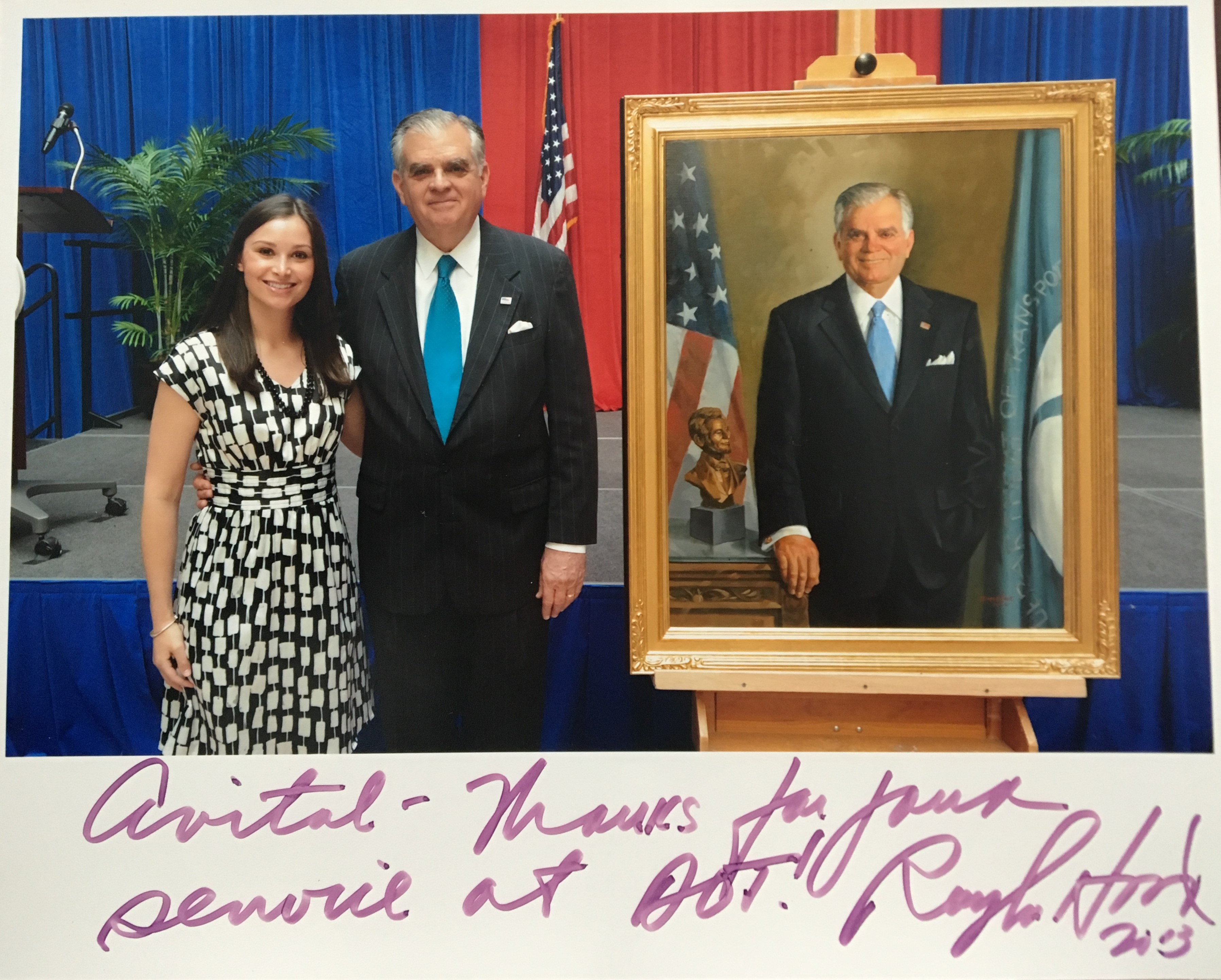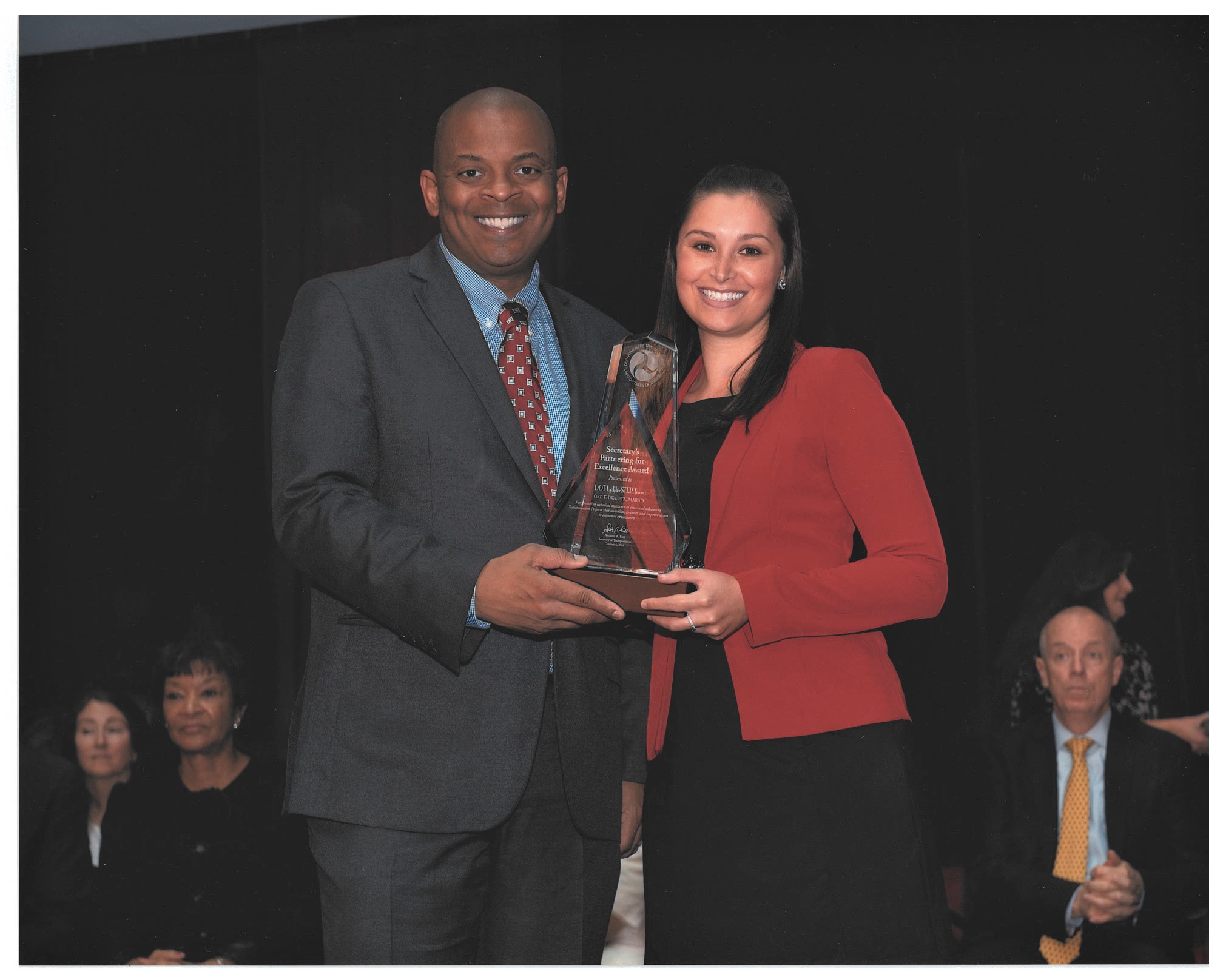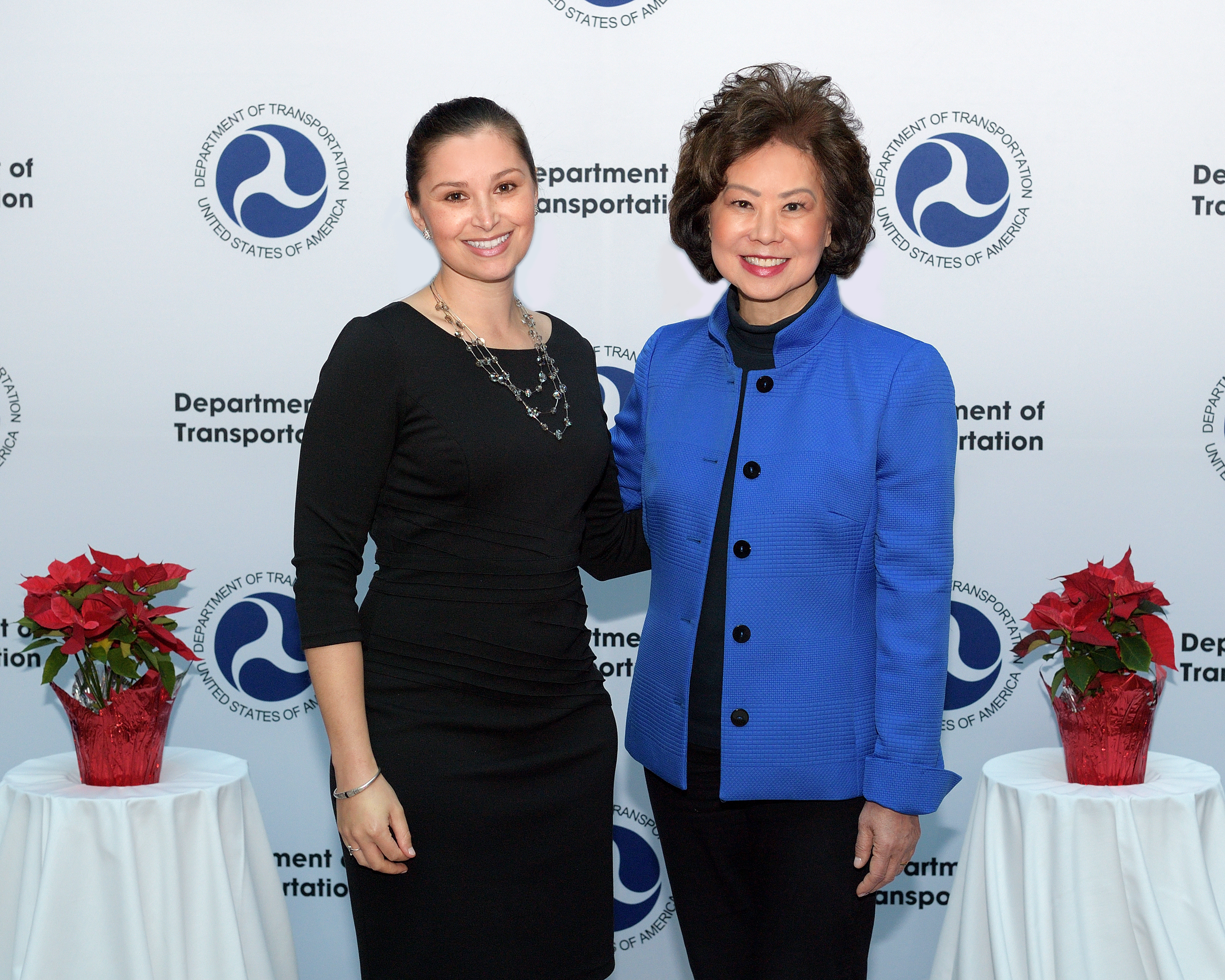Throughout my time in federal service at the U.S. Department of Transportation (USDOT), I had the honor of working under three Secretaries – Ray LaHood, Anthony Foxx, and Elaine Chao. Each strove to advance the policies and agendas of their bosses: President Obama for Secretaries LaHood and Foxx, and President Trump for Secretary Chao. However, each also had their own priorities and, in particular, a dedication to nurturing the transportation workforce.
 I joined the Federal Transit Administration as a Presidential Management Fellow (PMF) in 2011, when Ray LaHood was Secretary of USDOT. Secretary LaHood was known for his focus on safety and infrastructure investment, but in addition to these more traditional accomplishments, he also championed women joining the transportation field. For example, he signed a memorandum of understanding with the Women’s Transportation Seminar (WTS) to encourage women and girls to pursue an education and career within the industry. Secretary LaHood also filled many of the top positions at USDOT with women, providing an opportunity for more diverse voices to shape and develop transportation policy.
I joined the Federal Transit Administration as a Presidential Management Fellow (PMF) in 2011, when Ray LaHood was Secretary of USDOT. Secretary LaHood was known for his focus on safety and infrastructure investment, but in addition to these more traditional accomplishments, he also championed women joining the transportation field. For example, he signed a memorandum of understanding with the Women’s Transportation Seminar (WTS) to encourage women and girls to pursue an education and career within the industry. Secretary LaHood also filled many of the top positions at USDOT with women, providing an opportunity for more diverse voices to shape and develop transportation policy.
The following year, after gaining a basic understanding of policymaking, I recognized the opportunity to see firsthand how transportation legislation is crafted and I secured a six-month detail assignment with the U.S. Senate Committee on Finance. The surface transportation bill SAFETEA-LU had expired in 2009, and in 2012 the Finance Committee was still working to identify funding sources to pay for reauthorization. At the time, having to “shore up” the Highway Trust Fund was a fairly new phenomenon, and to close this gap, the Finance Committee needed to find $21.2 billion in offsets just to maintain current spending levels. What I learned during my detail is that this money ended up coming from a variety of sources often unrelated to transportation, including: pension smoothing ($9.4 billion), phased government employee retirement ($500 million), a transfer from the Leaking Underground Storage Tank Trust Fund ($2.4 billion), a tax on roll-your-own tobacco ($100 million), and more.
As an aside, Senator Barbara Boxer, then Chair of the Environment and Public Works Committee, joked at the time that she considered naming this transportation funding bill “SAFETEA-STEW” in honor of her husband, Stewart, since SAFETEA-LU had been named in part after then-House Transportation and Infrastructure Committee Chairman Don Young’s wife, Lu. Despite Senator Boxer’s suggestion, the new bill ended up being called MAP-21.
 Following the passage of MAP-21, I returned to USDOT and joined the Office of the Secretary, which offered greater access to USDOT leadership. Around the same time, Secretary LaHood stepped down and Anthony Foxx took his place as the new U.S. Secretary of Transportation.
Following the passage of MAP-21, I returned to USDOT and joined the Office of the Secretary, which offered greater access to USDOT leadership. Around the same time, Secretary LaHood stepped down and Anthony Foxx took his place as the new U.S. Secretary of Transportation.
Secretary Foxx continued Secretary LaHood’s commitment to gender diversity, which provided me an opportunity to serve as one of USDOT’s representatives to the White House Council on Women and Girls. Through this effort, USDOT – along with every other federal department – spearheaded and supported policies and public programs to advance the welfare of women and girls. This initiative brought senior USDOT leaders together to discuss everyday transportation challenges females disproportionally face – such as safety and traveling with children – and how the department could help ameliorate such challenges through policies, programs, and funding.
During his childhood, Secretary Foxx experienced how transportation decisions made at the federal level could affect families by both connecting and dividing neighborhoods, and as a result committed himself to implementing policies to reconnect communities, create jobs, and provide access to opportunities through transportation.
One of my favorite assignments during Secretary Foxx’s tenure involved coordinating a “TED Talk”-style presentation he gave on this topic. During a brainstorming meeting, I suggested the Secretary could practice his talk in front of PMFs from across the federal government, who would be an eager audience yet wouldn’t necessarily be transportation experts. The Secretary agreed and so we invited PMFs from every government agency throughout Washington, DC to hear his presentation. Seeing my idea come to fruition helped build confidence and reinforced the fact that new ideas can be generated by bringing people with diverse backgrounds to the table.
 In another instance of furthering diversity in transportation, Elaine Chao became USDOT Secretary in 2017 – only the third woman and second Asian American to serve in this position since the department’s creation fifty years prior. With a new administration came new priority areas, and under Secretary Chao, USDOT focused on removing burdensome regulations and right-sizing the role of federal involvement in local projects. Secretary Chao also set a tone of gratitude within USDOT, regularly emailing staff to thank them for their service and holding an annual open house where she made herself available for an entire afternoon to greet staff in person.
In another instance of furthering diversity in transportation, Elaine Chao became USDOT Secretary in 2017 – only the third woman and second Asian American to serve in this position since the department’s creation fifty years prior. With a new administration came new priority areas, and under Secretary Chao, USDOT focused on removing burdensome regulations and right-sizing the role of federal involvement in local projects. Secretary Chao also set a tone of gratitude within USDOT, regularly emailing staff to thank them for their service and holding an annual open house where she made herself available for an entire afternoon to greet staff in person.
Under both Secretaries Foxx and Chao, my portfolio included working on the multimodal TIGER discretionary grant program, renamed BUILD transportation grants in 2018. Given his commitment to providing opportunity through transportation, Secretary Foxx awarded TIGER grants to projects he felt would revitalize and connect communities, often through public transportation. In contrast, projects selected for award by Secretary Chao reflected the Trump administration’s focus on addressing disinvestment in rural communities while supporting overall economic growth. Although both leaders took different approaches informed by their distinct priorities, they ultimately sought to achieve the same goal of enhancing quality of life for the American people through transportation investment.
I left USDOT at the beginning of 2019, and while I miss having a front row seat in federal policymaking, I consider myself very fortunate to have worked for three impactful Secretaries and on Capitol Hill, especially at an early stage in my career. I am thankful for the opportunity to have been a civil servant, for the policy lessons I learned, and for working with a variety of leaders – including many women – who served as role models.
The best advice I can give from my time as a federal employee is not to be afraid of opportunity: go to meetings and events, introduce yourself, ask questions, and learn from each experience. You never know where that next opportunity will lead.

 I joined the Federal Transit Administration as a Presidential Management Fellow (PMF) in 2011, when Ray LaHood was Secretary of USDOT. Secretary LaHood was known for his focus on safety and infrastructure investment, but in addition to these more traditional accomplishments, he also championed women joining the transportation field. For example, he signed a memorandum of understanding with the Women’s Transportation Seminar (WTS) to encourage women and girls to pursue an education and career within the industry. Secretary LaHood also filled many of the top positions at USDOT with women, providing an opportunity for more diverse voices to shape and develop transportation policy.
I joined the Federal Transit Administration as a Presidential Management Fellow (PMF) in 2011, when Ray LaHood was Secretary of USDOT. Secretary LaHood was known for his focus on safety and infrastructure investment, but in addition to these more traditional accomplishments, he also championed women joining the transportation field. For example, he signed a memorandum of understanding with the Women’s Transportation Seminar (WTS) to encourage women and girls to pursue an education and career within the industry. Secretary LaHood also filled many of the top positions at USDOT with women, providing an opportunity for more diverse voices to shape and develop transportation policy. Following the passage of MAP-21, I returned to USDOT and joined the Office of the Secretary, which offered greater access to USDOT leadership. Around the same time, Secretary LaHood stepped down and Anthony Foxx took his place as the new U.S. Secretary of Transportation.
Following the passage of MAP-21, I returned to USDOT and joined the Office of the Secretary, which offered greater access to USDOT leadership. Around the same time, Secretary LaHood stepped down and Anthony Foxx took his place as the new U.S. Secretary of Transportation. In another instance of furthering diversity in transportation, Elaine Chao became USDOT Secretary in 2017 – only the third woman and second Asian American to serve in this position since the department’s creation fifty years prior. With a new administration came new priority areas, and under Secretary Chao, USDOT focused on removing burdensome regulations and right-sizing the role of federal involvement in local projects. Secretary Chao also set a tone of gratitude within USDOT, regularly emailing staff to thank them for their service and holding an annual open house where she made herself available for an entire afternoon to greet staff in person.
In another instance of furthering diversity in transportation, Elaine Chao became USDOT Secretary in 2017 – only the third woman and second Asian American to serve in this position since the department’s creation fifty years prior. With a new administration came new priority areas, and under Secretary Chao, USDOT focused on removing burdensome regulations and right-sizing the role of federal involvement in local projects. Secretary Chao also set a tone of gratitude within USDOT, regularly emailing staff to thank them for their service and holding an annual open house where she made herself available for an entire afternoon to greet staff in person.

